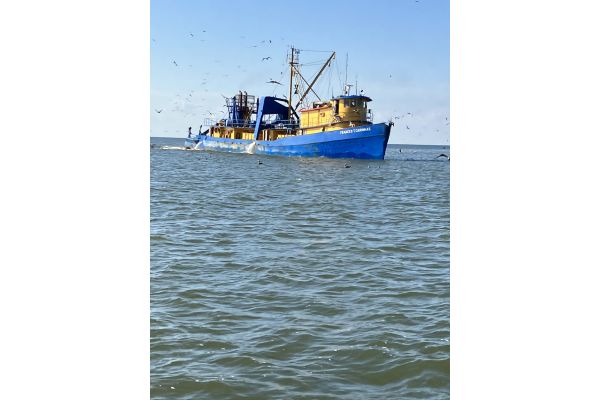The new Notice of Intent could once again permit industrial menhaden harvest in waters as shallow as five feet – rolling back a successful 2024 conservation measure developed through collaboration between anglers, industry, and state leaders.
(Baton Rouge, La.)—The Louisiana Wildlife and Fisheries Commission (LWFC) voted 4-3 today to move forward with a Notice of Intent (NOI) that could allow industrial pogy boats to again fish within a quarter-mile of most Louisiana beaches – eliminating a broader half-mile buffer zone that the industry agreed to in 2024 after negotiations with recreational angling and conservation groups, LWFC, and the Louisiana Department of Wildlife and Fisheries.
Despite overwhelming public opposition – including testimony, written comments, and letters from nearly 200 Louisiana-based and national conservation organizations and fishing tackle companies urging the Commission to keep industrial fishing for pogies – also called menhaden – at least ½-mile off Louisiana’s coastline, the Commission sided with the two foreign-controlled menhaden companies operating in the state.
“Today’s decision is extremely disappointing for anglers, conservationists, and those who care about Louisiana’s coastal ecosystems and habitat,” said Chris Macaluso, director of fisheries for the Theodore Roosevelt Conservation Partnership. “In 2024, anglers, conservationists, and the menhaden industry reached a compromise to establish modest protections for Louisiana’s shallow coastal waters by setting a half-mile buffer off most Louisiana beaches. What happened today is nothing less than the industry and their political allies backing out of that deal.”
Commission Chairman Kevin Sagrera of Abbeville, La. – where Canadian-owned Omega Protein owns one of its two Gulf-based processing plants – instructed Louisiana Department of Wildlife and Fisheries staff in October to draw maps that reduced the ½-mile buffers to ¼-mile across most of the coast at the behest of the industry. The other industrial menhaden company operating in the Gulf is South African-controlled Daybrook Fisheries, which runs a processing plant in Empire, La.
The ½-mile buffers were enacted prior to the 2024 menhaden fishing season after two massive fish kill events were caused by the industry’s boats, as well as net tears in 2022 and 2023, that resulted in wasting millions of dead pogies, redfish, croakers, and other fish that washed up on Louisiana beaches. Menhaden reduction vessels draft around 10 feet, but will now again be permitted to fish in water as shallow as 5 feet if the NOI is ultimately approved in spring 2026.
“What happened today not only undermines public trust in our state’s ability to conservatively manage its fisheries, but will ultimately will result in harm to fragile coastal habitats and fish like redfish and speckled trout, whose populations have already declined over the past decade.” Macaluso said.
The Theodore Roosevelt Conservation Partnership analyzed menhaden industry-related fish kill and spill information from 2024 and determined that the estimated number of fish spilled was reduced by 74 percent after the ½-mile buffer was instituted. Menhaden harvest data from NOAA Fisheries database also revealed that – despite industry claims that the buffers were resulting in a loss of jobs, profits, and fewer fish harvested – 2024 harvest levels were similar to levels during the 2021 and 2014 fishing seasons and that the dockside value of the Gulf menhaden harvest increased by a full $60 million from 2021-2024.
A 2024 study that thoroughly examined bycatch associated with the Gulf industrial menhaden fishery showed that more than 140 million non-target fish were killed along with menhaden by industrial vessels that year alone, including 22,000 breeding-size redfish (which are illegal to harvest by recreational anglers), 240,000 speckled trout, more than 80 million croaker, 25 million white trout, 5.5 million white shrimp as well as millions of other species like spot, black drum, catfish, sharks, and rays. An additional 8,000 smaller redfish, Louisiana’s only saltwater gamefish, were killed and along with menhaden reduced by the industry into fish oil, fish meal, and other industrial products. The 2024 study also showed that bycatch of speckled trout, redfish, and other species increased in net sets made in water shallower than 22 feet deep.
The LWFC was set to approve a 1-mile buffer coastwide in early 2024 after extensive public outcry about the millions of dead fish spoiling on Louisiana’s beaches in the previous two seasons. That decision was delayed by Louisiana Governor Jeff Landry’s administration, which eventually insisted both recreational fishing and conservation advocates, along with the menhaden industry, accept a ½-mile buffer as a compromise.
The vote to reduce the current ½-mile buffer will include a 60-day public comment period to begin on December 19 and conclude on January 23, 2026. Should the LWFC give final approval to the NOI after the comment period, the Louisiana Legislature has the option to conduct an oversight hearing of the decision and could remand the decision back to LWFC for changes, if deemed necessary.
Founded in 2002, the TRCP is the largest coalition of conservation organizations in the country, uniting and amplifying the voices of sportsmen and women by convening hunting and fishing groups, conservation organizations, and outdoor businesses to a common purpose.
Read the full article here




